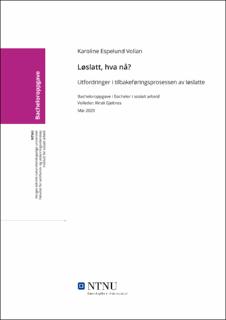| dc.contributor.advisor | Gjeitnes, Kirsti | |
| dc.contributor.author | Vollan, Karoline Espelund | |
| dc.date.accessioned | 2021-09-28T18:44:45Z | |
| dc.date.available | 2021-09-28T18:44:45Z | |
| dc.date.issued | 2020 | |
| dc.identifier | no.ntnu:inspera:56776074:22064573 | |
| dc.identifier.uri | https://hdl.handle.net/11250/2785651 | |
| dc.description.abstract | Temaet i denne oppgaven er rehabiliteringen og tilbakeføringen av domfelte, og hvordan dette ivaretas av kriminalomsorgen og samarbeidende instanser. Rehabiliteringen under soning er, utover det å redusere forekomsten av ny kriminalitet, en sentral del i arbeidet med å bedre levekårene til de domfelte. Det er ofte bakenforliggende faktorer som bidrar til at mennesker begår lovbrudd. Enkelte kan ha hatt en vanskelig oppvekst med dårlige levekår, eller at de har havnet i feil miljø. Målet med rehabiliteringen i fengsel er at det skal bidra med å bearbeide personlige utfordringer, samt styrke framtidsutsikter og forberede den domfelte på et liv uten kriminalitet. Studier viser derimot at disse målene ikke blir nådd, og at flere havner bak fengselsmurene igjen (Justis- og beredskapsdepartementet, 2017, s. 3).
Problemstillingen jeg vil utforske i denne oppgaven er derfor: Hvordan jobber kriminalomsorgen og samarbeidende instanser for å sikre tilbakeføring av domfelte ved løslatelse? Målsettingen med oppgaven er å belyse sviktene i tilbakeføringsprosessen. Hva som forårsaker svikt, og hvor i prosessen dette skjer. Rehabiliteringen skal starte fra den domfelte starter soningen og skal videreføres av samarbeidende instanser ved løslatelse. Ideelt sett skal de etter hvert kunne leve et liv som likeverdige borgere i samfunnet, men resultatene samsvarer ikke nødvendigvis med dette idealet. Intervjuer av innsatte viser at det ved flere avdelinger ikke tas hensyn til de domfeltes rett til medvirkning. Mistillit mellom innsatte og ansatte, og uenighet blant hjelpeinstanser om ansvarsområder setter hinder for rehabiliteringen, og dårlig kommunikasjonsflyt og samhandling vanskeliggjør tilbakeføringen. | |
| dc.description.abstract | The topic of this thesis is the rehabilitation of convicts and their societal reintegration, and how this is safeguarded by the criminal justice services and cooperating bodies. Rehabilitation is a key part of the efforts to improve the living conditions of the convicts, as well as reducing the incidence of new crime. People who commit criminal offences often have underlying factors contributing to this. Some may have had a difficult upbringing with poor living conditions, others may have ended up in the wrong crowd. The goal of prison rehabilitation is to help process personal challenges, strengthen their prospects and prepare the convicts for a life without crime. Studies, on the other hand, show that these goals are not being met and that numerous convicts end up back in jail.
Consequently, I will explore how does the criminal justice service and cooperative bodies work to ensure societal reintegration of convicted persons upon release. In this thesis, I will attempt to highlight the shortcomings in the process of reintegration, and subsequently clarify probable causes and the settings in witch these shortcomings occur. Rehabilitation should commence from the moment the convicts begin their sentence, and sustained by cooperating bodies upon release. Ideally, convicts should eventually achieve a sense of equal citizenship in society, but the result do not match this ideal. Interviews of inmates show that several public institutions do not take into account the inmates right to participate in decision concerning their own treatment. Distrust between inmates and the criminal justice services, and disagreement over responsibilities among the key figures in the criminal justice system impede rehabilitation. Furthermore, reintegration is hindered by poor communication flow and inadequate collaboration between relief and work agencies. | |
| dc.language | | |
| dc.publisher | NTNU | |
| dc.title | Løslatt, hva nå? - Utfordringer i tilbakeføringsprosessen av løslatte. | |
| dc.type | Bachelor thesis | |
